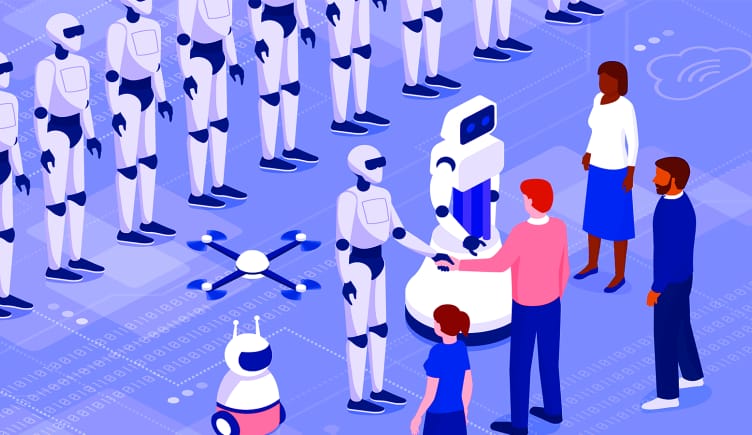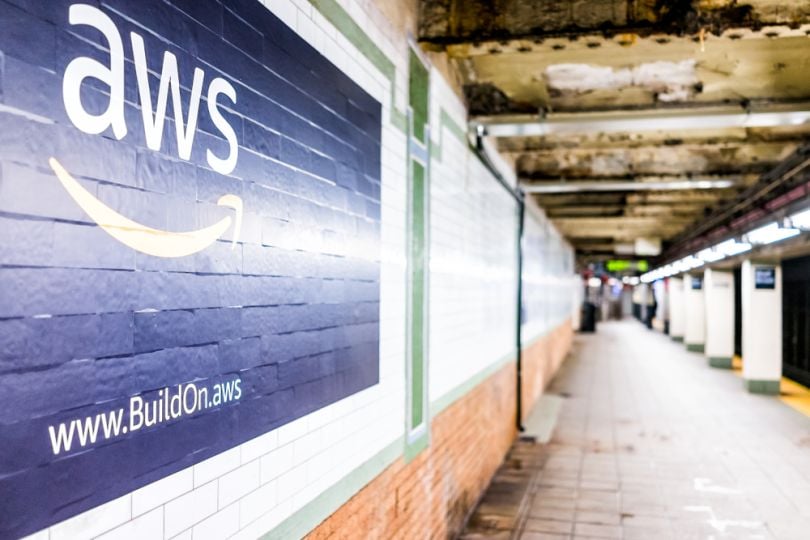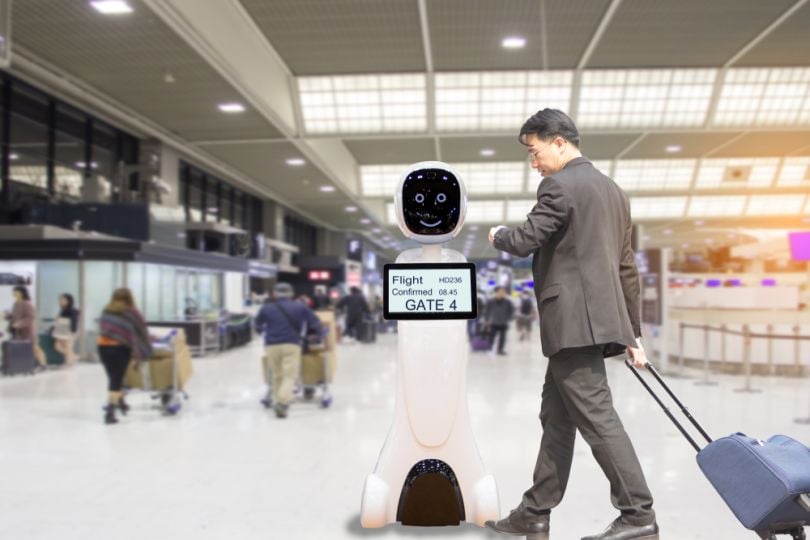 Image: Shutterstock / Built In
Image: Shutterstock / Built In
Robots are often a tremendous capital expenditure for companies looking to automate their business processes.
The high cost is often a major barrier to entry for companies working in logistics, manufacturing, fulfillment and other industries where automation is often required to not only remain competitive, but to counteract labor shortages.
But some robotics companies are taking an alternative approach to selling their robots outright. Instead, they’re adopting a robotics-as-a-service business model so their customers can lease, or rent, robots without having to shell out an exorbitant amount of money at the outset.
What Is Robotics as a Service?
What Is Robotics as a Service (RaaS)?
Robotics as a service is a subscription-style business model where robotics companies offer clients and customers the opportunity to rent robots for use across industries from logistics and manufacturing to service and hospitality. As a result, companies that want to incorporate automation tools into their workplace — like robotic vacuums in hotels or autonomous forklifts in warehouses — no longer have to contend with the high costs typically associated with purchasing advanced automation tools outright.
The upfront cost of setting up an automated warehouse operation with 50 to 100 robots could cost a company between $2 million to $4 million, according to a 2021 report from Research and Markets. A robotics-as-a-service model would break up that high cost over time, making adoption more manageable, and realistic. And while RaaS models increase the time it takes a robotics company to cover their own costs, they’ll end up making more money over the lifetime of the robot.
Brad Porter, founder and CEO of Collaborative Robotics, an early stage robotics venture that’s developing a cobot for use across industries, equates RaaS to a financing model that plays to a company’s return on investment.
Robotics-as-a-Service Business Models
- Time-based leases: With time-based RaaS models, customers lease a robot from a robotics company for a specific period of time or term, say on a weekly or monthly basis.
- Task-based leases: With task-based RaaS models, customers lease a robot and pay the robotics company based on how many tasks the robot performs.
“When people talk about robotics as a service, there are kind of two sub models — one where people are leasing rather than owning the equipment and another where they’re maybe paying per transaction that the robot performs,” Porter told Built In. “I think leasing versus owning is mostly a financing question like, ‘Who’s holding the bank note on the equipment purchase?’”
Many robotics companies offer both types of leases, though task-based leases, where companies pay per task, like picking goods in a warehouse, can prove riskier for robotics companies, especially startups.
According to Porter, the companies who own the equipment hold much of the risk when it comes to task-based, or pay-per-task, leases. If the customer isn’t using the equipment, or it’s not being used as much as projected, there’s little incentive for a company to offer a task-based RaaS model, though robotics companies will often set minimums to counteract any underutilization.
And then for companies with cash in the bank, they’ll likely still choose to purchase robots outright.
“I think if you know that the equipment is going to work well for you, and you’re someone deep pocketed — like you’re a big company with the financial reserves, you would rather buy it and depreciate it over five years than effectively paying some amount of overhead on that,” Porter said.
More on RoboticsRobots Aren’t Just for High-Tech Labs and Heavy Industry Anymore. And That’s a Good Thing.
How Is RaaS Used?
Robotics-as-a-service business models aren’t always so cut and dry. Companies often mix and match, renting and buying robots based on needs or market trends. Sometimes companies will rent first and then buy, or bring in robots during peak demand seasons to support order fulfillment.
Ilan Cohen, chairman and CEO of Caja Robotics, a robotics company that focuses on “goods-to-person” robots and software in the e-commerce and third-party logistics industries, told Built In his company takes a hybrid approach to sales, offering clients the option to lease robots from the company or buy them outright. Many companies opt to buy outright as a capital expenditure, according to Cohen, though those who do buy will often rent more robots during peak demand times, typically around the holidays.
“One thing we see a lot of is, ‘Hey, we can try it before we buy it,’ in a way that’s much less arduous from a capital cycle, or from a procurement friction perspective, inside the companies.”
“I think this is the real need of the customer,” Cohen said. “Because between the peak season and non-peak season … the performance that you need, or the activity that you need, for the same warehouse, can be three times, four times, the average.”
Seth Winterroth, a partner at Eclipse, has worked with and invested in companies like 6 River Systems and Third Wave Automation, both of which specialize in autonomous mobile robots and other automation solutions for logistics and material handling industries.
Most companies he works with offer a RaaS model, pricing on a monthly basis with a term contract, he said. Their customers are growing more receptive to these as-a-service style business models, partly because it gives companies an opportunity to see these robots or other automation tools in action.
“One thing we see a lot of is, ‘Hey, we can try it before we buy it,’ in a way that’s much less arduous from a capital cycle, or from a procurement friction perspective, inside the companies,” Winterroth said.
Examples of Robotics as a Service
As an increasing number of robotics companies are now offering RaaS options to their clients. From companies that focus on warehouse robots to delivery robots, here are a few companies offering RaaS options to customers.
Aethon: Aethon, which specializes in autonomous mobile robots that work in healthcare and hospitality settings, offers a RaaS option to its clients and customers. “The flavor more associated with RaaS today is charging per unit of work rather than per robot,” Aethon CEO Peter Sieff told the Association for Advancing Automation earlier this year. “Instead of charging for the hardware and software as a product itself you pay for the service it is delivering. Aethon offers both.”
Cobalt Robotics: Robots from Cobalt Robotics provide automated safety and security solutions to businesses and facilities. They’re able to patrol areas, respond to incidents like spills and provide customer service. Cobalt’s hourly RaaS model not only provides robots, but also software, customer support and maintenance.
InVia Robotics: InVia Robotics’ RaaS model is marketed as a subscription-based service. InVia, which specializes in robots working in logistics, also has a robotics operation center that provides system monitoring and support.
Locus Robotics: Autonomous mobile robots from Locus Robotics work everywhere from fulfillment centers to hospitals. The company’s RaaS model works as a subscription service and comes with 24-hour support as well as software and hardware updates.
Relay Robotics: Relay Robotics’ delivery robot, Relay+, works in healthcare, hotels and even residential buildings. The company’s RaaS model includes service and support with leases and can operate for as low as $4 an hour, according to the company’s website.
More on Robotics in LogisticsGoing Somewhere Fast: Why Logistics Tech Is Surging
RaaS Is Growing in Popularity
Racheli Vizman is the co-founder and CEO of SavorEat, an Israeli tech company that developed a robotic system that cooks customizable plant-based burgers. SavorEat offers a RaaS model, which provides food service operators the opportunity to rent the company’s robot chef on a monthly basis along with service, support and training, she told Built In.
While some SavorEat customers just buy the robot chef, “others prefer the convenience and flexibility of not taking the upfront fixed cost charge, but instead spreading payment across a RaaS model,” Vizman said.
According to Vizman, citing SavorEat’s market research, RaaS is becoming more popular, with an estimated compound annual growth rate in the “double digits” over the next five years.
“Others prefer the convenience and flexibility of not taking the upfront fixed cost charge, but instead spreading payment across a RaaS model.”
Business research firm Technavio expects the RaaS market to increase in value by about $1.2 billion over the next five years, with a compound annual growth rate of around 18 percent.
While customers benefit from the flexibility and lower barrier to entry RaaS offers, companies like SavorEat are benefiting from the growing RaaS trend.
“For us as the provider, it gives us greater visibility into predicting revenue and planning supply for the demand,” Vizman said.
These benefits ultimately balance risk for both robotics companies and their clients, which makes RaaS a sustainable alternative, or complement, to traditional sales models in the robotics industry.
If the website content violates your rights, please contact us to delete it。








